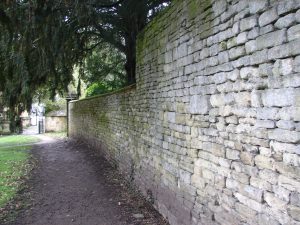 The Augustinian Abbey of Saint Mary in Cirencester plays a major role in Templar’s Prophecy, the fourth book in my Lady Apollonia West Country Mystery Series. The abbey played a major role in Cirencester for over 400 years until the Dissolution of the Monasteries by King Henry VIII in the 16th century and most of it has disappeared as I described in my previous posting.
The Augustinian Abbey of Saint Mary in Cirencester plays a major role in Templar’s Prophecy, the fourth book in my Lady Apollonia West Country Mystery Series. The abbey played a major role in Cirencester for over 400 years until the Dissolution of the Monasteries by King Henry VIII in the 16th century and most of it has disappeared as I described in my previous posting.
Still, there are traces of the abbey in and around Cirencester. The abbey grounds were bordered on two sides by the old Roman wall of which some parts are gone but others are visible. The Norman arch at the far corner of the grounds from the site of the church was erected as a gatehouse in the 12th century. Ruins of the Roman wall are visible running next to the River Churn. Also, the wall that separated the abbey church from the nearby parish church and its churchyard is still standing. The picture at the top shows a portion of the abbey wall as viewed from the churchyard of the parish church.
A sign along Dollar Street in Cirencester marks the medieval gatehouse or Dole Hall where alms were distributed by the monastery. The street name, Dollar Street, a corruption of dole, is derived from this activity. Just outside the abbey grounds are a few arches from the 12th century Saint John’s Hospital which the abbey acquired in the 13th century. Also, on the edge of town are a dovecote and the barn of Barton Grange which the abbey owned and used.
The Corinium Museum has surviving artefacts from the abbey and displays which give the visitor a view of abbey life in the fourteenth century. Artefacts from the abbey include carvings of monks and popes, medieval tiles, and pieces of stone fan vaulting.
The abbey also had responsibility for Saint John Baptist, the parish church of which the abbot was the rector. I will talk more about that church in my next posting. Shortly after the time of my story, the abbey built the south porch of the church and used the second storey of the porch as a town hall because they controlled the market. Their newly built town hall overlooked the Marketplace.
For more information on Cirencester Abbey, click on
https://en.wikipedia.org/wiki/Cirencester_Abbey or on
http://www.british-history.ac.uk/vch/glos/vol2/pp79-84
Tags: Chaucer's England, historical fiction, medieval mysteries